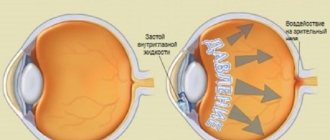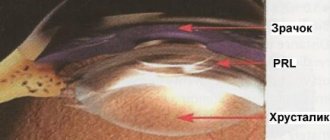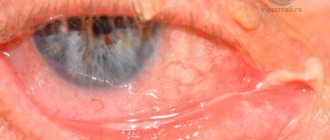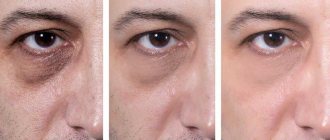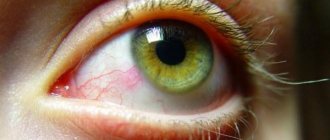Pain in the eyes can be a symptom of a concomitant illness - a cold, flu, migraine - or a sign of an ophthalmological disease that requires urgent treatment. The eyes can hurt inside and out, and there are pulsating sensations caused by overwork when the optic nerve is strained. When blurred vision and the appearance of mucous discharge are added, this indicates a serious illness. Corneal ulcers, burns, and mechanical damage may cause eye pain.
If severe pain occurs suddenly, you should immediately consult a doctor to prevent the development of serious consequences.
Presence of a foreign body
If you were unable to detect a grain of sand or a microscopic speck in your eye, this does not mean that they are not there. Sometimes these particles are so small that only an ophthalmologist using an ophthalmic (slit) lamp can see and remove them.
There are more reasons to suspect the presence of a speck if you previously had to be in the wind, in a dusty room, or work with welding or diffuse materials.
To get rid of the unpleasant sensation, you will need to remove the unwanted object. During the examination, the ophthalmologist will examine the cornea of the eye under a lamp and, if necessary, use a special dye (fluorescein). It will clearly indicate a foreign object in the eye and the extent of erosion (damage) to the cornea.
Ingrown eyelash
Among the reasons that cause a feeling of something disturbing in the eye is an eyelash that grows incorrectly. It affects the cornea and causes discomfort.
When blinking, the eyelash damages the cornea, causing redness and the feeling of a foreign body. At the same time, the eye is very watery, as if it were pricking. When you search for a grain of sand in your eye, you cannot find it, because there is nothing there. An ophthalmologist can see an ingrown eyelash during an examination by carefully turning out the eyelid.
Here, during the examination, he removes it, after which the patient is prescribed eye drops and goes home.
Prevention
To prevent disturbances in the functioning of the visual organs, you need to take good care of your health and use only individual towels if there is a patient with an infectious eye disease in the house. Proper nutrition, eating foods containing vitamin A - carrots, blueberries. You should not try to treat your vision on your own if you feel severe acute pain, an injury has occurred, or a foreign object has entered the eye. Some pathologies are caused by impaired blood circulation in the organs of vision; timely contact with a specialist will help prevent serious complications and protect your vision!
When prescribing treatment, you need to follow the recommendations of the ophthalmologist, observe the regime of eye strain, give rest after an hour of working at the computer, and perform exercises to relax the muscles of the visual organ.
Damage to the cornea from contact lenses
When wearing contact lenses, the cause of the sensation of a foreign object in the eye may be due to improper use. In this case, the upper layer of the cornea is damaged, which causes lacrimation, photophobia, pain, and a feeling of speck, although nothing has gotten into the eye.
Corneal erosion from exposure to contact lenses can be detected during an examination by an ophthalmologist. He will conduct an examination and recommend treatment.
If corneal erosion is diagnosed, you will need to stop wearing lenses for a while.
If a large area of damage is detected, the prescribed drugs will include:
- 1. Keratoprotectors for restoring damaged corneas: Vidisik, Oftagel, Hydropromellose, Visimetin, Oksial, Karakol.
- 2. Hydrocortisone or antihistamines to relieve inflammation with severe swelling and redness.
- 3. Levomycytin, Floxal or Tobrex to prevent bacterial infection.
- 4. Taufon to accelerate the improvement of recovery processes.
If you have corneal erosion, you should not:
- 1. Rub your eyes as this will cause more damage.
- 2. Touch your eyes with cotton swabs or sponges.
- 3. Self-prescribe eye drops.
Corneal erosion occurs when the top layer is damaged by debris, eyelashes, contact lenses and other traumatic factors.
If the disease is not treated in time, it can lead to a serious complication (neovascularization of blood vessels), which leads to complete blindness..
How to treat eye diseases
At the first signs of visual impairment or pain, you should consult a doctor. Treatment and diagnosis depend on the severity of the disease and symptoms. Diagnosis includes identifying factors such as:
- Duration and intensity of pain;
- Whether the development of the syndrome is gradual or sudden;
- Patient use of medications.
Additionally, medical procedures are performed:
- Visual acuity testing;
- Ultrasound of the visual organs;
- Biomicroscopy;
- Measuring intraocular pressure;
- Taking tear and mucous material.
After the procedures, depending on the underlying cause, therapy is prescribed. Cataracts, glaucoma, mechanical injuries require surgical intervention. For inflammatory, infectious lesions, dry eye syndrome, drops are prescribed up to 5 times a day, antihistamines, anti-inflammatory, antimicrobial medications. If vision deteriorates, lenses and glasses are selected for constant wear or for work or reading.
Dry eye syndrome
Swelling and redness of the cornea, a feeling of pain, the presence of a foreign body that is not there may be a sign of dry eye syndrome.
The causes of the pathology may be:
- 1. Frequent stay in rooms with dry air (heating radiators, air conditioners) or exposure to the wind.
- 2. Pathologies of the eyelids that provoke their non-closure.
- 3. Working at a computer, watching TV for long periods of time, or driving at night. These activities provoke infrequent blinking, which negatively affects the hydration of the eyes.
Dry eye syndrome is caused by drying out of the cornea, which occurs when there is insufficient amount of tear fluid washing it.
When in a dry room, tears dry out very quickly, and this leads to drying out of the cornea and provokes unpleasant symptoms.
A simple test will help determine the presence of the initial stage of this disease:
| Symptoms encountered over the past 7 days | Constantly | Often | 50 to 50 | Rarely | Never |
| Hypersensitivity to light | 4 | 3 | 2 | 1 | |
| Feeling of dust on the cornea | 4 | 3 | 2 | 1 | |
| Pain or redness of the cornea | 4 | 3 | 2 | 1 | |
| Fog before my eyes | 4 | 3 | 2 | 1 | |
| Decreased visual acuity | 4 | 3 | 2 | 1 | |
| Activities you did in the past week | |||||
| Reading | 4 | 3 | 2 | 1 | |
| Driving a car in the dark | 4 | 3 | 2 | 1 | |
| Staying at a computer monitor | 4 | 3 | 2 | 1 | |
| Watching TV | 4 | 3 | 2 | 1 | |
| The presence of a feeling of discomfort in the following situations over the past 7-10 days. | |||||
| During windy weather | 4 | 3 | 2 | 1 | |
| In areas with very dry atmosphere (humidity below 30%) | 4 | 3 | 2 | 1 | |
| In air-conditioned rooms | 4 | 3 | 2 | 1 |
The points in the cells with the selected answer options are summed up. A result in the range of 36-48 points indicates a possible severe degree of pathology, 24-35 - moderate, 12-23 - mild.
At increased loads, to reduce discomfort, it is necessary to drip into the eyes drugs such as 'artificial tears': Visin, Hilo-Komod, Vidisik, 'Artificial tears'. If the air in the room is too dry, it is advisable to humidify it. But in any case, you will need to consult a doctor for advice.
Conservative treatment of the syndrome is long-term and requires reducing the time spent working at the computer, watching TV and driving at night. If there is a threat of corneal ulceration, tamponade of the lacrimal canal and other therapeutic measures will be required.
Classification of pain by nature
The nature of the pain indicates a possible disease.
- Aching is a symptom of keratitis, early stage glaucoma, dislocation of the eye lens, hypotension.
- Stitching pain is associated with inflammation and injury. Sometimes the eyes can sting in windy weather, with changes in atmospheric pressure, or with a sharp change in the temperature of the eyeball.
- A feeling of squeezing occurs with colds, flu, and migraines.
- Throbbing pain in one eye occurs with overwork, stress, or emotional outburst. Sometimes it is a symptom of traumatic brain injury, vascular pathologies of the brain, diseases that cause changes in the cornea and iris of the eye.
Additional symptoms more accurately indicate the disease. The doctor will help determine why the eyes hurt based on the patient's descriptions of the symptoms.
Glaucoma
With glaucoma, the eye reacts very sensitively to light, and the slightest increase in its brightness causes photophobia and a feeling of specks in the eye. If you have a severe headache, nausea, or floaters, you should seek medical help as soon as possible.
An acute attack of glaucoma requires hospitalization and urgent treatment, as there is a rapid drop in visual acuity, which then does not recover.
If there is a sensation of a foreign body in the eye for more than 2-3 days, severe itching or pain, or excessive production of tears, you should seek help from an ophthalmologist. He will determine the cause of the discomfort and recommend how to get rid of it.
Causes of stabbing pain
Unpleasant sensations can be short-term, mild or long-lasting and most painful and nagging. There are many factors that cause such pain.
Ophthalmological diseases such as astigmatism, blepharitis, glaucoma, conjunctivitis, stye are accompanied by redness of the eyes and the appearance of severe or moderate pain. Source: flickr (noreenfrances).
The most common causes of acute pain in the eye:
- overwork of the eye muscles, overstrain is caused by incorrectly selected lenses, prolonged work with office equipment;
- stress, headaches;
- entry of foreign bodies;
- injuries;
- various diseases, both ophthalmological and other.
Inflammatory processes in the eye
Among the inflammatory processes that cause discomfort are conjunctivitis, blepharitis, and keratitis. They can be of viral, bacterial or allergic origin. With viral and bacterial diseases, the infection enters the eyes both from other sources in the body (flu, acute respiratory infections, otitis, sinusitis, stomatitis, boils, etc.) and from sick people, animals, birds (with conjunctivitis). Allergic pathologies are the body’s reaction to an allergen.
Along with the feeling of a speck in the eye, itching, swelling, redness of the eyelids, conjunctiva and cornea, profuse lacrimation, pain, and photophobia occur.
Inflammatory diseases should be treated under the supervision of an ophthalmologist, since self-medication often provokes the spread of infection into the deeper structures of the eye.
What measures to take if you have a cutting pain in the eye?
If you experience any pain, you should consult an ophthalmologist; this will help to immediately identify the cause of acute pain and prevent further development of the disease. After the examination, the doctor prescribes an appropriate course of treatment, consisting of certain procedures, and pharmacological drugs are prescribed. In severe forms of ophthalmological disease, when foreign bodies enter or the eyes are damaged by various kinds of substances, surgical actions can be carried out.
Diagnostics includes ultrasound examination, study of the retina and cornea, and measurement of intraocular pressure. Peripheral vision is examined, biomicroscopy and analysis for infections are performed.
Purulent formations
The causes of unpleasant sensations, especially under the upper eyelid, can be chalazion or stye, including internal stye - meibomite. In the stage of infiltration, when there is no white spot, but inflammation is already present, severe itching occurs, redness of the edge of the eyelid occurs, the eye seems to sting, and a sensation of a foreign body appears.
Treatment of such formations at the infiltration stage involves dry heat. Folk remedies help well: applying baked onion gruel to the sore spot, rubbing with garlic (provided that precautions are taken). Other methods will become available after the pus has matured. In case of meibomitis and chalazion, the abscess is opened surgically and only then treated with eye drops.
If the cause of the discomfort is unknown, and the pain does not go away within 3-5 days, be sure to consult a doctor. The advanced form of any disease is much more difficult to treat.
Video

